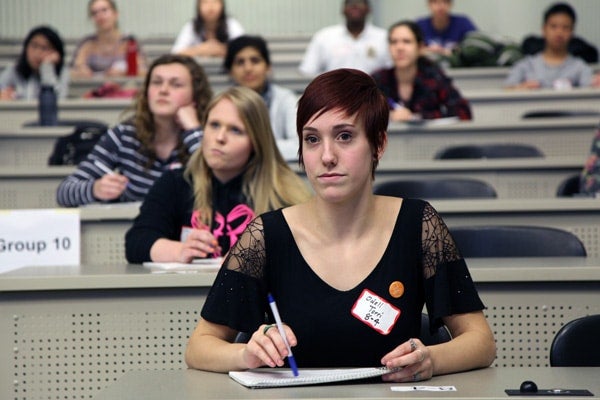
Faculty of Medicine hosts Brain Bee
Published: March 30, 2012
What brain region processes fear and anxiety? Which drug can break up blood clots to improve the outcome of a stroke? Where are neurotransmitters stored?
More than 100 high school students from across the Greater Toronto Area tackled questions like these in an intense, elimination-style “Brain Bee” held March 30 at the Faculty of Medicine.
The teenaged science enthusiasts, from Grades 9 to 12, were slowly whittled down to a group of finalists after participating in three timed rounds of questions revolving around brain physiology in health and disease. The challenge was run in a style similar to Jeopardy, with contestants scribbling their answers down on large pads and holding them up for scrutiny.
“Our overall aim is to motivate students to learn about the brain, to capture their imaginations and to inspire them to pursue careers in biomedical brain research,” said Physiology Professor Emeritus Jonathan Dostrovsky, who started the University of Toronto Brain Bee in 1999.
The top three Brain Bee finalists received a cash prize and a summer learning placement in a U of T neuroscience laboratory. The winner will go on to compete at the Canadian National Brain Bee at McMaster University in May, and will compete for a shot at attending the International Brain Bee held later this year in South Africa.
“I knew I wanted to go into medicine after getting my Bachelor’s degree but getting ready for the Brain Bee definitely made me more interested in the field of neuroscience and brain research,” said Torri Odell, a 16-year-old Grade 11 student at Donald A. Wilson Secondary School in Whitby.
Odell participated in the Brain Bee with seven other students from her high school, including 17-year-old Kevin Morey, who was particularly excited about the opportunity to mix and mingle with U of T faculty and graduate students.
“Even if we don’t win, it’s been a really great opportunity to learn about the brain and meet people who are in this field,” said Morey, who has already been accepted into several science programs – at U of T and elsewhere – for the fall.
The annual challenge is run in large part by more than two dozen U of T Neuroscience and Physiology graduate students, who coordinate study tutorials to prepare the teenaged contestants and highlight their current research to the delight of enthusiastic participants. Faculty and graduate students work together to create the challenge questions based on a study guide for Brain Bees.
“The Brain Bee not only provides a fantastic learning opportunity for the high school participants, it also gives our graduate students an excellent opportunity to exercise their leadership ability, which is a key component for our graduate training programs,” said Zhong-Ping Feng, an associate professor of Physiology at U of T and Brain Bee organizer.
In the beginning, only a couple dozen high schoolers participated in the Brain Bee but those numbers have dramatically increased as interest in brain health has skyrocketed, said Dostrovsky.
“If you look at what we’ve seen in the news even in the last while around issues like mental health and concussions, there is certainly a higher level of attention being paid to this area of study and I think that’s really capturing the attention of these young people,” he said, adding that Brain Bee participants often to go on to study Medicine.



